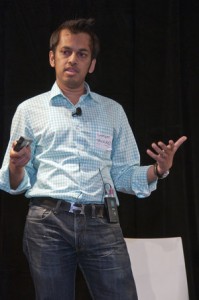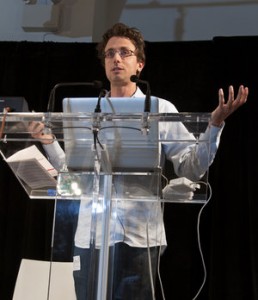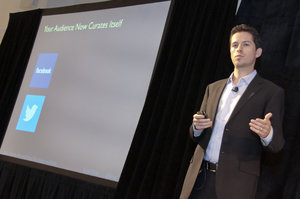Creating and Promoting Quality Content in a Social Media World
More than 100 participants, experts, and thought-leaders met at the first Innovate/Content mini-conference in Manhattan Thursday to discuss the future of publishing: from style and approach to the size and shape it takes in a social-media world.
What kind of content should we be making? What kind of content best helps brands and agencies to financially thrive (and sometimes just survive)?
Two points of focus were in evidence throughout the session:
- The relationship between high-quality content and shareable/profitable content;
- The relevancy, and possible ascendance, of long-form writing on the web.
Quality vs. shareability: making a difference, getting clicks
“I think the highest-quality content is the content that makes the most difference to the most people,” said Shane Snow, co-founder of Contently.
Publishers and brands such as The Verge, Red Bull, and Mashable have brought this kind of difference-making to readers in significant numbers, Snow said. The Verge, he noted, is in the top ten when it comes to blogs, in terms of influence.

Shafqat Islam
“They think about what the readers want first,” Snow said. “Not how they’re going to turn page views. Perhaps, paradoxically, that actually gets them more page views.”
But companies such as The Verge, and Red Bull, and Mashable, he acknowledged, also work with enough money that they can “use that budgetary advantage for unique and high-impact storytelling.”
And this is a concept that came up more than once in the conference: High quality often comes at a significant price.
Shafqat Islam, CEO and co-founder of NewsCred, asked the audience to consider the example of a brands promoting content that provides a rich experience for readers.
He highlighted Mr Porter, purveyors of high-end menswear. MrPorter.com is an immersive environment: words, ideas, and pictures of fine clothing, all intertwined, all telling stories about an experience.
“When you go to their site,” Islam said, “the link doesn’t say ‘buy.’ It says ‘read and buy.’ They focus so much on editorial, they actually have a weekly magazine.”

Jonah Peretti
Jonah Peretti, chief executive and co-founder of Buzzfeed (among other publishers), introduced a different kind of example. He said that when it comes to delivering what readers want, the focus must eventually turn to something like populism.
He made his case by referencing awhole category the comprises Buzzfeed’s most viral successes. In the main, this is content comprised of cute animal pictures — part of his platform’s stock and trade (when it’s not breaking White House news). These, he said, help to keep all the Buzzfeed content alive.
“Quality is something we all aspire to, and I aspire to it,” Peretti said. “But it’s almost a luxury. Although having really good, quality content is important, and is an important part of making a great business, you also have to think about what’s distributed, and how it spreads, and how it moves.”
The underlying point: traffic still drives revenue.
Longer reads online: design impacts length and timing
The takeaway, however, was not simply that high-brow/high-end content is nice to have but perhaps not as lucrative, in terms of revenue-attracting clicks, as 33 Animals Who Are Extremely Disappointed in You, which has more than 2.4 million views, as of Sept. 7.
Many of the presenters also noted that long-form journalism seems to be on the rise, online.

Bryan Birsic
Peretti himself said that the way users curate their own social-media experiences suggests that heavier, higher-concept writing stands to rise to the top — at least, within niches of interest.
“What social has really changed for the media business,” said Bryan Birsic, president of SimpleReach. “Is that you’re no longer curating your own content, increasingly so. Because your audience now curates itself.”
And, said, Peretti: “Longer-form content is doing great on social, where you’re not creating content for a robot, for a Google algorithm, you’re creating content for real people on Twitter who are reporters and political junkies and news hounds. And they know what’s good and what’s not good. And I think that’s good news for people doing harder and more serious journalism.”

Eli Pariser
And the good news is also that, according to Eli Pariser, chief executive and co-founder of Upworthy, old-media concepts of timeliness are now malleable.
“We really thought you had to get there first in order to harness that magical viral fairy dust,” Pariser said. “It turns out that that’s just totally not true. It just matters how well-suited it is to the moment you are in, and how well-packaged it is.”
Packaging is the trick, according to Snow, when it comes to the viability of long-form web content. He pointed to a recent article at The Verge about the history of dubstep.
“It was at least a 30–35 minute read,” he said. “They’re doing long-form content on the web, which is usually very difficult to pull off, but because of their design it comes off very elegant and amazing. And you should see the number of comments these guys got.”
Innovate/Content was co-hosted by Contently, Livefyre, NewsCred, Pulse, and SimpleReach.
All images courtesy of Jay Irani.
Get better at your job right now.
Read our monthly newsletter to master content marketing. It’s made for marketers, creators, and everyone in between.





